Operators
 Spain
Spain
| F.K.40 | |
|---|---|
| Role | Airliner |
| National origin | Netherlands |
| Manufacturer | Koolhoven |
| Designer | Frederick Koolhoven |
| First flight | 1928 |
| Primary user | KLM |
| Number built | 1 |
The Koolhoven F.K.40 was a small airliner built in the Netherlands in 1928 for KLM Royal Dutch Airlines. It was a conventional high-wing cantilever monoplane powered by a single engine in the nose. The fuselage was made of welded steel tube construction with a wooden wing skinned in plywood and held in place by four bolts to facilitate removal. The cabin was spacious for an aircraft of its size, and was intended to be readily reconfigured for passengers, mail, or freight. Although up to six seats could be fitted, the only F.K.40 built flew with four.
This aircraft, registered PH-AES and nicknamed Piet Haas ("Peter Hare"), was operated by KLM until it was sold into private hands in 1936. Shortly thereafter, it was sold to the Spanish Republican Air Force, and was operated as an air ambulance during the Spanish Civil War.
General characteristics
Performance
Related lists

The Fokker F.VIII was a large twin-engined airliner designed and produced by the Dutch aircraft manufacturer Fokker in the 1920s.

The Fokker F.IX was an airliner developed in the Netherlands in the late 1920s, intended to provide KLM with an aircraft suitable for regular services to the Dutch East Indies. When the onset of the Great Depression forced the postponement of those plans, the market for this aircraft disappeared as well, although it did see military service in Czechoslovakia as a bomber.

The BAT F.K.23 Bantam was a British single-seat fighter biplane produced by British Aerial Transport Company Limited of London during World War I.

The BAT F.K.26 was a British single-engined four-passenger biplane transport aircraft produced by British Aerial Transport Company Limited of London at the end of World War I.
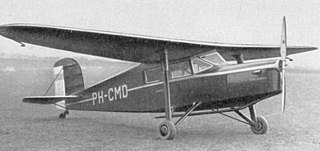
The Koolhoven F.K.43 was a small four-seat, single-engined monoplane passenger aircraft manufactured by Koolhoven in the Netherlands. It was a direct successor of the F.K.41.
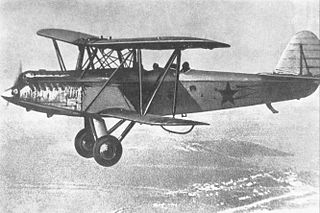
The Polikarpov R-5 was a Soviet reconnaissance bomber aircraft of the 1930s. It was the standard light bomber and reconnaissance aircraft of the Soviet Air Force for much of the 1930s, while also being used heavily as a civilian light transport, some 7,000 being built in total.

The Koolhoven F.K.51 was a 1930s Dutch two-seat basic training biplane built by the Koolhoven Company.

The Fokker F.XX was a 1930s Dutch three-engined airliner designed and built by Fokker. It was the first Fokker design to use an elliptical-section fuselage instead of the traditional square fuselage and the first Fokker aircraft with retractable landing gear.
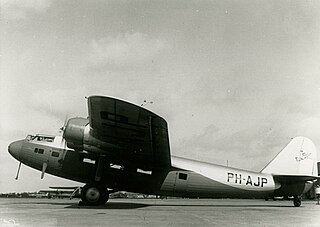
The Fokker F.XXII was a 1930s Dutch four-engined 22-passenger airliner designed and built by Fokker.

The Fokker F.XXXVI was a 1930s Dutch four-engined 32-passenger airliner designed and built by Fokker. It was the largest transport designed and built by Fokker.

The Fokker F.XII was a three-engined high-winged monoplane airliner produced in the 1930s by the Dutch aircraft manufacturer Fokker. Two aircraft were built under license by Danish Orlogsværftet. The first was powered by 347 kW (465 hp) Bristol Jupiter VI radial engines and the second, an improved model, the F.XIIM, was about 20 km/h (12 mph) faster than the Dutch-built F.XIIs.
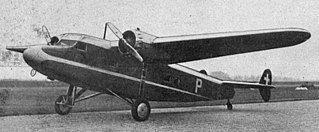
The Koolhoven F.K.50 was a 1930s Dutch eight-passenger light transport monoplane designed and built by Koolhoven.

The Fokker F.XVIII was an airliner produced in the Netherlands in the early 1930s, essentially a scaled-up version of the Fokker F.XII intended for long-distance flights. Like its predecessor, it was a conventional high-wing cantilever monoplane with fixed tailwheel undercarriage. Its cabin could seat 12 passengers, or four-to-six on seats convertible to sleeping berths. Only five were built, all for KLM, and registered as PH-AIO, 'AIP, 'AIQ, 'AIR and 'AIS, all of which were named after birds. Used by KLM on its Amsterdam-Batavia route, the F.XVIII became celebrated in the Netherlands due to two especially noteworthy flights. In December 1933, one aircraft was used to make a special Christmas mail flight to Batavia, completing the round trip in a flight time of 73 hours 34 minutes. The following Christmas, another F.XVIII made a similar flight to Curaçao in 55 hours 58 minutes after having been specially re-engined for the journey.
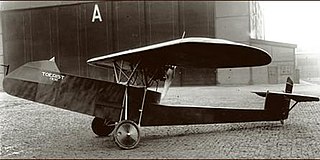
The Koolhoven F.K.30 Toerist was a small sport aircraft built in the Netherlands in 1927, intended for use by aeroclubs. The fuselage carried the pilot and one passenger in tandem in a bathtub-like open cockpit. The cantilever parasol wing was mounted above and behind them, with the main wheels of the fixed undercarriage directly below the wing, at the sides of the fuselage. The engine, driving a pusher propeller, was mounted on the aircraft centerline at the aft portion of the wing. The conventional empennage was carried on a boom extending below the propeller arc. The wing, including engine, was designed so that it could be pivoted 90° while on the ground, allowing the aircraft to be stored and transported more easily.
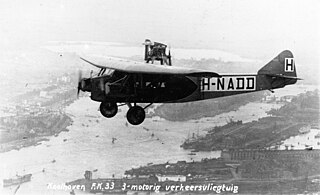
The NVI F.K.33 was an airliner built in the Netherlands in 1925 for use by KLM for night flying.

The Koolhoven F.K.48 was an airliner built in the Netherlands in 1934 for KLM.

The Koolhoven F.K.53 Junior was a small sport aircraft built in the Netherlands in 1936. It was a low-wing cantilever monoplane of conventional design, with tandem seating for two under a long canopy. The wings had a gull shape and carried the main units of the tailwheel undercarriage. Two examples were built, and both destroyed in the German bombing of Waalhaven in May 1940. The first machine built had been purchased by the Dutch national flying school.

The Northrop Delta was an American single-engined passenger transport aircraft of the 1930s. Closely related to Northrop's Gamma mail plane, 13 were produced by the Northrop Corporation, followed by 19 aircraft built under license by Canadian Vickers Limited.

The Avia 51 was a 1930s Czechoslovakian six-passenger commercial transport, designed by Robert Nebesář and built by Avia. The type was uneconomical in use and only three were built.

The Bréguet 470 Fulgur was a French airliner of the 1930s. Only a single example of the twin-engined monoplane was built, this being sold to the Spanish Republican government during the Spanish Civil War.
{{cite journal}}: Check |url= value (help)